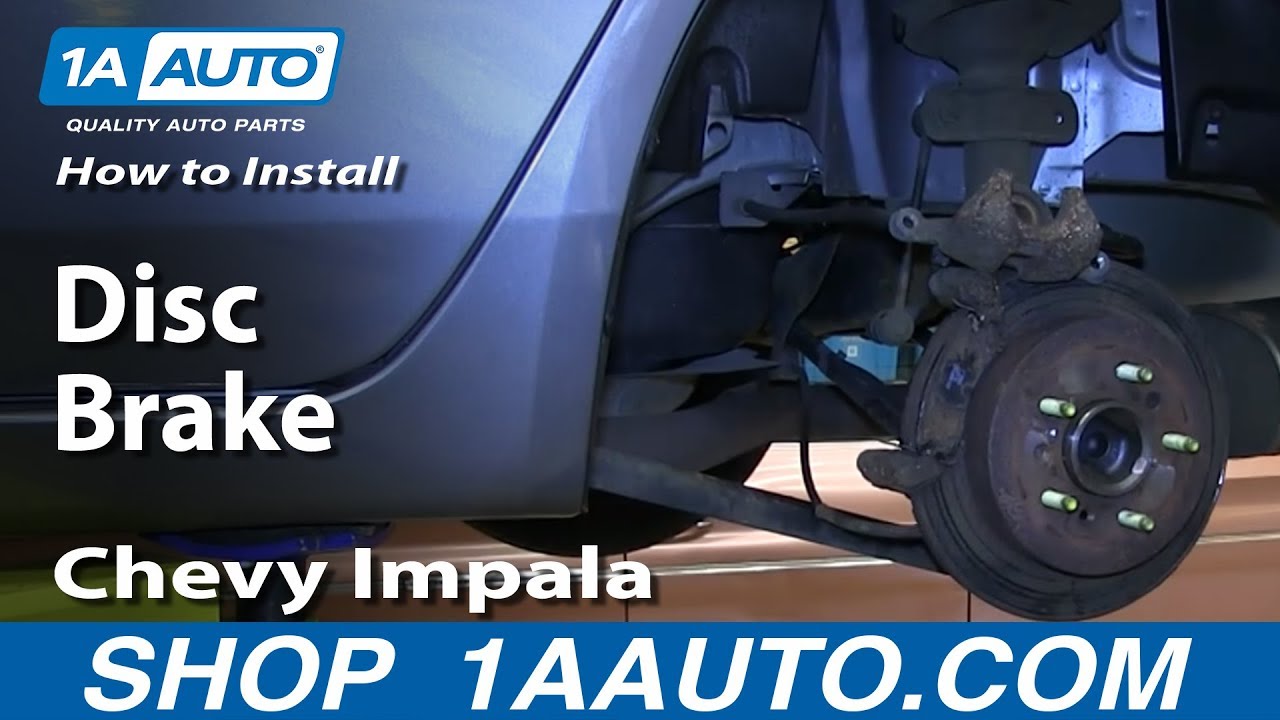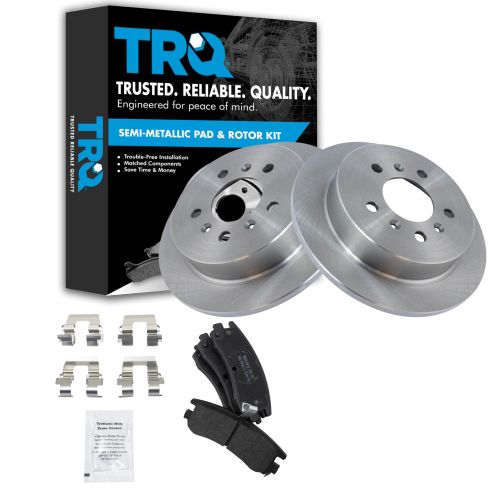
How to Replace Brake Kit 2006-10 Chevy Impala
Created on: 2013-09-08
Here's a video on how to service or replace the rear brakes on your 06-10 Chevy Impala.
-
step 1 :Removing the Wheel
- Remove the lug nut covers with a 19mm socket
- Pull off the center cap
- Loosen the lug nuts with the vehicle on the ground
- Raise the vehicle with a floor jack
- Secure the vehicle on jack stands
- Remove the lug nuts
- Pull off the wheel
-
step 2 :Inspecting the Brakes
- Check the thickness of the brake pads
- Check the brake pad wear indicator
- Check for gouges on both sides of the rotor
-
step 3 :Removing the Brake Pads
- Remove the two 14mm bolts from the brake caliper
- Pull the caliper aside
- Pry the brake pads off with a flat blade screwdriver
- Remove the brake pad slides
-
step 4 :Removing the Brake Rotor
- Remove the two 13mm bolts from the brake caliper bracket
- Pull off the brake caliper bracket
- Remove the T30 Torx bolt from the rotor
- Strike the rotor with a hammer to loosen it
- Pull the rotor off
-
step 5 :Preparing the New Brake Pads and Rotors
- Apply grease to the caliper slides
- Apply grease to the brake pad tabs
- Clean the brake pad slides with a wire brush
- Clean the rotor with brake parts cleaner
-
step 6 :Installing the New Brake Rotor
- Slide the rotor on
- Insert the T30 bolt into the rotor
- Put the bracket back into place
- Start the two 13mm bolts by hand
- Tighten the 13mm bolts to 75 foot-pounds of torque
-
step 7 :Installing the New Brake Pads
- Put the brake pad slides into the caliper bracket
- Install the new brake pads into the bracket
- Use a large C-clamp to push the caliper pistons back
- Put the caliper on
- Thread the two 14mm bolts by hand
- Tighten bolts to 60-65 foot-pounds
-
step 8 :Reattaching the Wheel
- Slide the wheel into place
- Start the lug nuts by hand
- Tighten the lug nuts preliminarily
- Lower the vehicle to the ground
- Tighten the lug nuts to 100 foot-pounds in a crossing or star pattern
- Reattach the center cap
- Tighten the lug nut covers with a 19mm socket
-
step 9 :Testing the Brakes
- Pump your brakes repeatedly until they feel firm
- Test your brakes at 5 miles per hour and then 10 miles per hour
- Road test the vehicle
Tools needed
-
13mm Socket
A Piece of Pipe (for leverage)
Torque Wrench
14mm Socket
Hammer
Jack Stands
19mm Socket
Brake Parts Cleaner
Flat Blade Screwdriver
T30 Driver
White Grease
Ratchet
Wire Brush
Floor Jack
1/2 Inch Breaker Bar
Brought to you by 1AAuto.com, your source for quality replacement parts and the best service on the Internet.
Hi, I'm Don from 1A Auto. I hope this how-to video helps you out, and next time you need parts for your vehicle, think of 1AAuto.com. Thanks.
In this video, we're going to show you how to service the rear brakes on this 2006 Chevy Impala. We're going to show you the right hand or passenger side. It's the same procedure for the left hand or driver side. The brakes on this vehicle are in good shape, so we just take them apart and put them back together to show you. Tools you'll need are 13, 14, and 19mm sockets with a ratchet, a breaker bar or a pipe for extra leverage; T30 Torx bit; flat blade screwdriver; hammer; large C-clamp; wire brush; and jack and jack stands.
Start off by using a 19mm socket and loosen the black lug nut covers. Then this leads to taking the wheel cover off on this vehicle. It may be different on yours. If you don't have the benefit of air tools, you'll want to loosen the lug nuts, then raise and secure the vehicle, then remove the lug nuts the rest of the way and remove the wheel and tire.
You can inspect the brakes. The pads have good life on them on this vehicle. You'll also want to inspect the rotor. Just run the back of your finger or a small screwdriver. You're checking for any large grooves, even though these don't look too good they are in great shape, so we'll actually just take them apart and put them back together to show you.
Two 14mm bolts hold the caliper to the caliper bracket. I'm going to use a breaker bar; you can use a ratchet and a piece of pipe for some extra leverage to loosen those bolts. Finish removing the bolt, and then the caliper comes right up and off. Set it up top. Then you can just pull your pads right out. Pull out the inside and the outside, and then there are slides that you want to pull off of the caliper brackets. You'll want to clean those up later.
Then there are two 13mm bolts that hold the caliper bracket right there. Again, you'll want a breaker bar or a piece of pipe for some extra leverage. We'll fast forward as we undo those. As you remove that bolt, then that caliper bracket will come up and off. Now, use a T30 Torx driver, and we recommend one that's on a ratchet like this style. It's a socket style. Hold it in place with the screwdriver, and then remove the screw that holds the rotor on place. Once you get that screw off, you use a hammer and a good wrap should break the rotor loose. Just make sure your caliper doesn't fall down. Then you can pull the rotor off.
Now, we're going to prepare everything to go back together. As I said before, the brakes on this car were in good shape, so we're just going to put them back together. We're greasing the slide bolts that came out of the caliper bracket, and we're going to put a little bit of grease on the ends of the pads to make sure that they slide in the slides fairly well. Last but not least, we'll take a wire brush and we'll clean off those slides really well before we remount them. Here, we'll just use some brake parts cleaner to clean off the rotor a little bit.
Now we're ready to install. Put the rotor back on the hub. Reinstall that Torx 30 screw that holds the disc to the hub. Put the caliper bracket back in place, and reinstall the two 13mm bolts that hold it in place. We'll fast forward as we tighten those up. Now we're going to torque those to 75 foot pounds.
Now we can put those stainless steel slides back into the caliper bracket and reinstall our pads. Do the outer one first, it should press right in, and the inner one. When installing new pads, you'll need to reset the piston in the caliper, so use a large C-clamp and tighten down against the piston and drive it back into the caliper. Now, we can put the caliper back on top of the caliper bracket and pads, and start the bolts in. We'll fast forwards as we put those in. You'll want to tighten them to 60 to 65 foot-pounds.
Now we can keep the speed going as we put the wheel back in place, put the lug nuts on, and tighten them preliminarily. With the vehicle back down on the ground and secured in place, torque the lug nuts to 100 foot-pounds using a star pattern. Once you have them torqued, then you can put the wheel cover, or cap, back on and put that back in place. Just use your hand and a socket to tighten up those lug covers.
Last but not least, always make sure you get in and pump the brake pedal a bunch of times and make sure you get a nice firm pedal before you road test the vehicle.
We hope this video helps you out. Brought to you by www.1AAuto.com, your source for quality replacement parts and the best service on the Internet. Please feel free to call us toll-free, 888-844-3393. We're the company that's here for you on the Internet and in person.
Shop Products

Chevrolet Buick Rear Driver & Passenger Side Semi-Metallic Brake Pad & Rotor Kit TRQ BKA11607
Part Details:
- Semi-Metallic
- Premium Posi
- Solid
- 10.94 in. (278mm)
- 5 Lug
- (2) Rear Brake Rotors
- (1) Rear Semi-Metallic Brake Pad Set

How to Replace Front Brakes 2001-06 BMW 325Ci
How to repair, install, fix, change or replace your own worn, squeaky, fading old brakes on 06 BMW 325Ci
